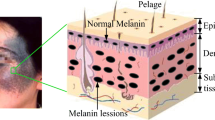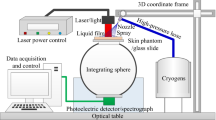Abstract
Laser cartilage reshaping (LCR) with cryogen spray cooling is a promising modality for producing cartilage shape change while reducing cutaneous thermal injury. However, LCR in thicker tissues, such as auricular cartilage, requires higher laser power, thus increasing cooling requirements. To eliminate the risks of freeze injury characteristic of high cryogen spray pulse rates, a carbon dioxide (CO2) spray, which evaporates rapidly from the skin, has been proposed as the cooling medium. This study aims to identify parameter sets which produce clinically significant reshaping while producing minimal skin thermal injury in LCR with CO2 spray cooling in ex vivo rabbit auricular cartilage. Excised whole rabbit ears were mechanically deformed around a cylindrical jig and irradiated with a 1.45-μm wavelength diode laser (fluence 12–14 J/cm2 per pulse, four to six pulse cycles per irradiation site, five to six irradiation sites per row for four rows on each sample) with concomitant application of CO2 spray (pulse duration 33–85 ms) to the skin surface. Bend angle measurements were performed before and after irradiation, and the change quantified. Surface temperature distributions were measured during irradiation/cooling. Maximum skin surface temperature ranged between 49.0 to 97.6 °C following four heating/cooling cycles. Significant reshaping was achieved with all laser dosimetry values with a 50–70 °C difference noted between controls (no cooling) and irradiated ears. Increasing cooling pulse duration yielded progressively improved gross skin protection during irradiation. CO2 spray cooling may potentially serve as an alternative to traditional cryogen spray cooling in LCR and may be the preferred cooling medium for thicker tissues. Future studies evaluating preclinical efficacy in an in vivo rabbit model are in progress.






Similar content being viewed by others
References
Bradbury ET, Hewison J, Timmons MJ (1992) Psychological and social outcome of prominent ear correction in children. Br J Plast Surg 45(2):97–100
Adamson PA, Strecker HD (1995) Otoplasty techniques. Facial plastic surgery: FPS 11(4):284–300. doi:10.1055/s-2008-1064545
Chae Y, Aguilar G, Lavernia EJ, Wong BJ (2003) Characterization of temperature dependent mechanical behavior of cartilage. Lasers Surg Med 32(4):271–278. doi:10.1002/lsm.10167
Protsenko DE, Zemek A, Wong BJ (2008) Temperature dependent change in equilibrium elastic modulus after thermally induced stress relaxation in porcine septal cartilage. Lasers Surg Med 40(3):202–210. doi:10.1002/lsm.20611
Keefe MW, Rasouli A, Telenkov SA, Karamzadeh AM, Milner TE, Crumley RL, Wong BJ (2003) Radiofrequency cartilage reshaping: efficacy, biophysical measurements, and tissue viability. Arch Facial Plast Surg 5(1):46–52
Ho KH, Diaz Valdes SH, Protsenko DE, Aguilar G, Wong BJ (2003) Electromechanical reshaping of septal cartilage. Laryngoscope 113(11):1916–1921
Protsenko DE, Ho K, Wong BJ (2006) Stress relaxation in porcine septal cartilage during electromechanical reshaping: mechanical and electrical responses. Ann Biomed Eng 34(3):455–464. doi:10.1007/s10439-005-9051-y
Manuel CT, Foulad A, Protsenko DE, Sepehr A, Wong BJ (2010) Needle electrode-based electromechanical reshaping of cartilage. Ann Biomed Eng 38(11):3389–3397. doi:10.1007/s10439-010-0088-1
Wu EC, Protsenko DE, Khan AZ, Dubin S, Karimi K, Wong BJ (2011) Needle electrode-based electromechanical reshaping of rabbit septal cartilage: a systematic evaluation. IEEE transactions on bio-medical engineering. doi:10.1109/TBME.2011.2157155
Helidonis E, Sobol E, Kavvalos G, Bizakis J, Christodoulou P, Velegrakis G, Segas J, Bagratashvili V (1993) Laser shaping of composite cartilage grafts. Am J Otolaryngol 14(6):410–412
Jones N, Sviridov A, Sobol E, Omelchenko A, Lowe J (2001) A prospective randomised study of laser reshaping of cartilage in vivo. Lasers Med Sci 16(4):284–290
Ayhan M, Deren O, Gorgu M, Erdogan B, Dursun A (2002) Cartilage shaping with the Er:YAG laser: an in vivo experimental study. Ann Plast Surg 49(5):527–531. doi:10.1097/01.SAP.0000015491.74572.5D
Gorgu M, Ayhan M, Aslan G, Erdogan B, Tuncel A (2000) Cartilage shaping using the Er:YAG laser: preliminary report. Ann Plast Surg 45(2):150–154
Mordon S, Wang T, Fleurisse L, Creusy C (2004) Laser cartilage reshaping in an in vivo rabbit model using a 1.54 microm Er:glass laser. Lasers Surg Med 34(4):315–322. doi:10.1002/lsm.20029
Wang Z, Perrault DF Jr, Pankratov MM, Shapshay SM (1996) Endoscopic laser-assisted reshaping of collapsed tracheal cartilage: a laboratory study. Ann Otol Rhinol Laryngol 105(3):176–181
Leclere FM, Petropoulos I, Buys B, Mordon S (2010) Laser assisted septal cartilage reshaping (LASCR): a prospective study in 12 patients. Lasers Surg Med 42(8):693–698. doi:10.1002/lsm.20958
Ovchinnikov Y, Sobol E, Svistushkin V, Shekhter A, Bagratashvili V, Sviridov A (2002) Laser septochondrocorrection. Arch Facial Plast Surg 4(3):180–185
Leclere FM, Petropoulos I, Mordon S (2010) Laser-assisted cartilage reshaping (LACR) for treating ear protrusions: a clinical study in 24 patients. Aesthetic plastic surgery 34(2):141–146. doi:10.1007/s00266-009-9353-9
Nelson JS, Milner TE, Anvari B, Tanenbaum BS, Kimel S, Svaasand LO, Jacques SL (1995) Dynamic epidermal cooling during pulsed laser treatment of port-wine stain. A new methodology with preliminary clinical evaluation. Arch Dermatol 131(6):695–700
Waldorf HA, Alster TS, McMillan K, Kauvar AN, Geronemus RG, Nelson JS (1997) Effect of dynamic cooling on 585-nm pulsed dye laser treatment of port-wine stain birthmarks. Dermatologic surgery: official publication for American Society for Dermatologic Surgery [et al] 23(8):657–662
Nelson JS, Milner TE, Anvari B, Tanenbaum BS, Svaasand LO, Kimel S (1996) Dynamic epidermal cooling in conjunction with laser-induced photothermolysis of port wine stain blood vessels. Lasers Surg Med 19(2):224–229. doi:10.1002/(SICI)1096-9101(1996) 19:2<224::AID-LSM15>3.0.CO;2-6
Verkruysse W, Majaron B, Tanenbaum BS, Nelson JS (2000) Optimal cryogen spray cooling parameters for pulsed laser treatment of port wine stains. Lasers Surg Med 27(2):165–170
Kelly KM, Nelson JS, Lask GP, Geronemus RG, Bernstein LJ (1999) Cryogen spray cooling in combination with nonablative laser treatment of facial rhytides. Arch Dermatol 135(6):691–694
Jia W, Svaasand LO, Nguyen TB, Nelson JS (2007) Dynamic skin cooling with an environmentally compatible alternative cryogen during laser surgery. Lasers Surg Med 39(10):776–781. doi:10.1002/lsm.20582
Holden PK, Chlebicki C, Wong BJ (2009) Minimally invasive ear reshaping with a 1450-nm diode laser using cryogen spray cooling in New Zealand white rabbits. Arch Facial Plast Surg 11 6:399–404. doi:10.1001/archfacial.2009.17
Chang CJ, Cheng SM, Chiu LL, Wong BJ, Ting K (2008) Minimizing superficial thermal injury using bilateral cryogen spray cooling during laser reshaping of composite cartilage grafts. Lasers Surg Med 40(7):477–482. doi:10.1002/lsm.20652
Lim A, Protsenko DE, Wong BJ (2011) Changes in the tangent modulus of rabbit septal and auricular cartilage following electromechanical reshaping. J Biomech Eng 133(9):094502. doi:10.1115/1.4004916
Zhang R, Ramirez-San-Juan JC, Choi B, Jia W, Aguilar G, Kelly KM, Nelson JS (2006) Thermal responses of ex vivo human skin during multiple cryogen spurts and 1,450 nm laser pulses. Lasers Surg Med 38(2):137–141. doi:10.1002/lsm.20297
Ragab A (2010) Carbon dioxide laser-assisted cartilage reshaping otoplasty: a new technique for prominent ears. Laryngoscope 120(7):1312–1318. doi:10.1002/lary.20951
Karamzadeh AM, Chang JC, Diaz S, EM T, Wong BJ (2005) Long-term in vivo stability of rabbit nasal septal cartilage following laser cartilage reshaping: a pilot investigation. Lasers Surg Med 36(2):147–154. doi:10.1002/lsm.20123
Karam AM, Protsenko DE, Li C, Wright R, Liaw LH, Milner TE, Wong BJ (2006) Long-term viability and mechanical behavior following laser cartilage reshaping. Arch Facial Plast Surg 8(2):105–116. doi:10.1001/archfaci.8.2.105
Arnoczky SP, Aksan A (2000) Thermal modification of connective tissues: basic science considerations and clinical implications. J Am Acad Orthop Surg 8(5):305–313
Chao KK, Ho KH, Wong BJ (2003) Measurement of the elastic modulus of rabbit nasal septal cartilage during Nd:YAG (lambda=1.32 microm) laser irradiation. Lasers Surg Med 32(5):377–383. doi:10.1002/lsm.10176
Wright R, Protsenko DE, Diaz S, Ho K, Wong B (2005) Shape retention in porcine and rabbit nasal septal cartilage using saline bath immersion and Nd:YAG laser irradiation. Lasers Surg Med 37(3):201–209. doi:10.1002/lsm.20212
Strayer DS, Rubin E (2009) Environmental and nutritional pathology. In: Rubin E, Reisner HM (eds) Essentials of Rubin's pathology, 5th edn. Lippincott Williams & Wilkins, Philadelphia
Acknowledgments
The authors thank the American Society for Laser Medicine and Surgery (2010 Student Research Grant to Mr. Wu and Dr. Horace Furumoto Innovations Award to Dr. Jia), the Department of Defense (DR090349, Deployment Related Medical Research Program to Dr. Wong), the National Institute for Dental and Craniofacial Research (1R21DE019026 to Dr. Wong), and the National Institutes of Health (AR59244, Laser Microbeam and Medical Program to Dr. Nelson) for providing funding support for this study. The authors also acknowledge institutional support from the Beckman Laser Institute Endowment and the Packard Foundation.
Author information
Authors and Affiliations
Corresponding author
Additional information
J. Stuart Nelson, MD, PhD has intellectual property rights with Syneron/Candela Corporation. The remaining authors report no conflicts of interest or financial disclosures. This study was presented as an oral and poster at the 2011 American Society for Laser Medicine and Surgery Annual Conference in Grapevine, TX.
Rights and permissions
About this article
Cite this article
Wu, E.C., Sun, V., Manuel, C.T. et al. Ex vivo investigations of laser auricular cartilage reshaping with carbon dioxide spray cooling in a rabbit model. Lasers Med Sci 28, 1475–1482 (2013). https://doi.org/10.1007/s10103-012-1250-9
Received:
Accepted:
Published:
Issue Date:
DOI: https://doi.org/10.1007/s10103-012-1250-9




